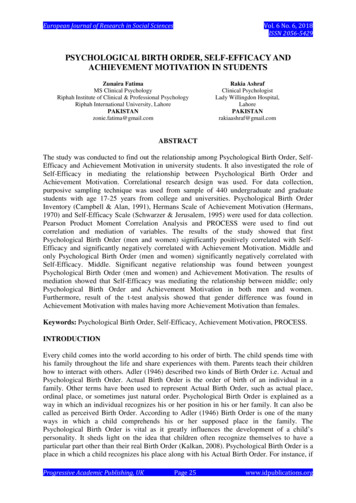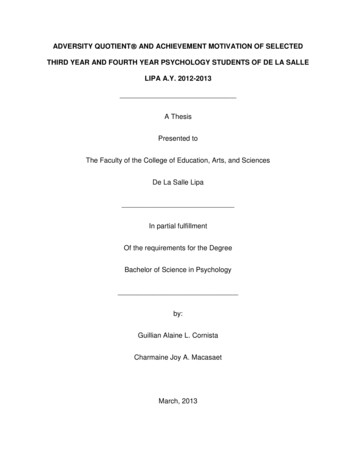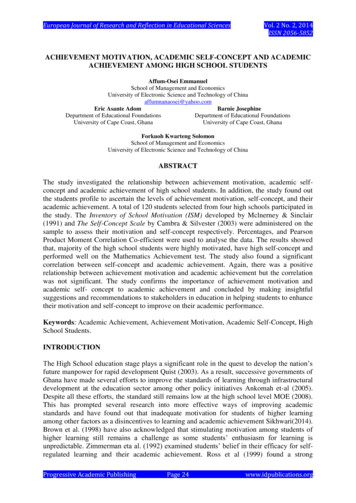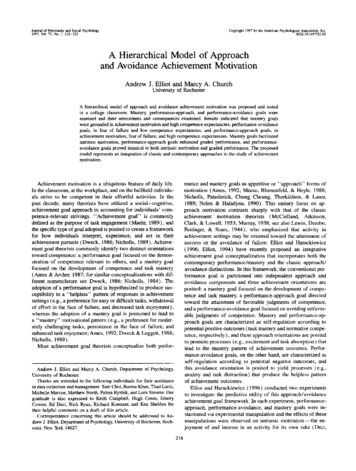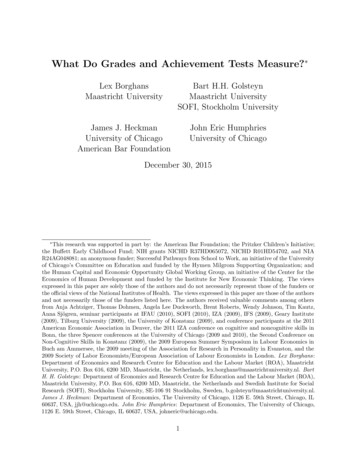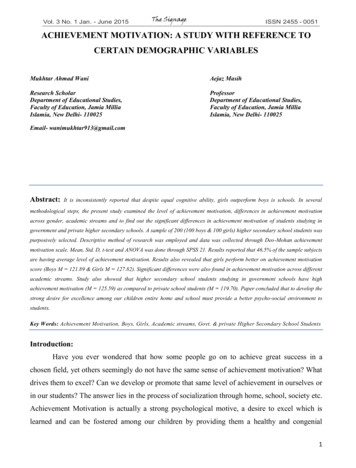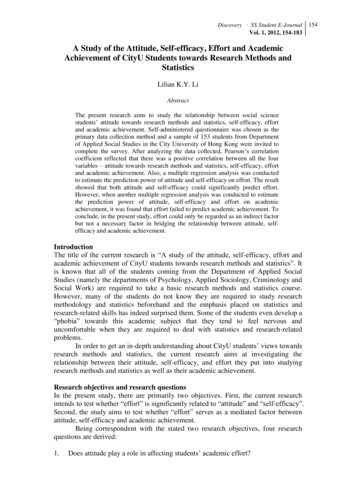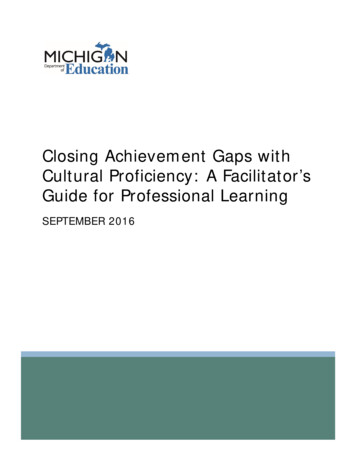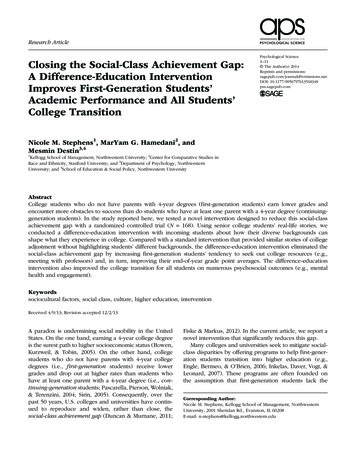
Transcription
518349Stephens et al.The Social-Class Achievement GapResearch ArticleClosing the Social-Class Achievement Gap:A Difference-Education InterventionImproves First-Generation Students’Academic Performance and All Students’College TransitionPsychological Science1–11 The Author(s) 2014Reprints and : 10.1177/0956797613518349pss.sagepub.comNicole M. Stephens1, MarYam G. Hamedani2, andMesmin Destin3,41Kellogg School of Management, Northwestern University; 2Center for Comparative Studies inRace and Ethnicity, Stanford University; and 3Department of Psychology, NorthwesternUniversity; and 4School of Education & Social Policy, Northwestern UniversityAbstractCollege students who do not have parents with 4-year degrees (first-generation students) earn lower grades andencounter more obstacles to success than do students who have at least one parent with a 4-year degree (continuinggeneration students). In the study reported here, we tested a novel intervention designed to reduce this social-classachievement gap with a randomized controlled trial (N 168). Using senior college students’ real-life stories, weconducted a difference-education intervention with incoming students about how their diverse backgrounds canshape what they experience in college. Compared with a standard intervention that provided similar stories of collegeadjustment without highlighting students’ different backgrounds, the difference-education intervention eliminated thesocial-class achievement gap by increasing first-generation students’ tendency to seek out college resources (e.g.,meeting with professors) and, in turn, improving their end-of-year grade point averages. The difference-educationintervention also improved the college transition for all students on numerous psychosocial outcomes (e.g., mentalhealth and engagement).Keywordssociocultural factors, social class, culture, higher education, interventionReceived 4/9/13; Revision accepted 12/2/13A paradox is undermining social mobility in the UnitedStates. On the one hand, earning a 4-year college degreeis the surest path to higher socioeconomic status (Bowen,Kurzweil, & Tobin, 2005). On the other hand, collegestudents who do not have parents with 4-year collegedegrees (i.e., first-generation students) receive lowergrades and drop out at higher rates than students whohave at least one parent with a 4-year degree (i.e., continuing-generation students; Pascarella, Pierson, Wolniak,& Terenzini, 2004; Sirin, 2005). Consequently, over thepast 50 years, U.S. colleges and universities have continued to reproduce and widen, rather than close, thesocial-class achievement gap (Duncan & Murnane, 2011;Fiske & Markus, 2012). In the current article, we report anovel intervention that significantly reduces this gap.Many colleges and universities seek to mitigate socialclass disparities by offering programs to help first-generation students transition into higher education (e.g.,Engle, Bermeo, & O’Brien, 2006; Inkelas, Daver, Vogt, &Leonard, 2007). These programs are often founded onthe assumption that first-generation students lack theCorresponding Author:Nicole M. Stephens, Kellogg School of Management, NorthwesternUniversity, 2001 Sheridan Rd., Evanston, IL 60208E-mail: n-stephens@kellogg.northwestern.edu
2financial resources (e.g., money for books) or academicskills (e.g., extra preparatory coursework) that they needto be successful. For example, the standard approach ofmany institutions is to offer “bridge” programs that teachstudents general academic tips and strategies, such ashow to study for exams or choose a major.Although financial resources and academic skills arenecessary, they do not guarantee success for first-generation students as they transition into the world of highereducation. First-generation students also need psychological resources, including the belief that people whohave backgrounds like theirs deserve to attend collegeand can thrive there (Oyserman & Destin, 2010; C. M.Steele, 2010; Stephens, Markus, & Fryberg, 2012).Compared with their continuing-generation peers, firstgeneration students are especially likely to feel left outand to have trouble finding their place (Housel & Harvey,2009; Johnson, Richeson, & Finkel, 2011; Ostrove & Long,2007). Many also struggle to navigate the middle-classculture of higher education, learn the “rules of the game,”and take advantage of college resources (Housel &Harvey, 2009; Ostrove & Long, 2007). For example, firstgeneration students frequently lack knowledge abouthow to select a major, find an internship, or build theirresumes (Reay, Crozier, & Clayton, 2009). These background-specific obstacles can undermine first-generationstudents’ academic performance and limit their opportunity to succeed (Stephens, Fryberg, Markus, Johnson, &Covarrubias, 2012; Stephens, Townsend, Markus, &Phillips, 2012). Because U.S. colleges and universities seldom acknowledge how social class can affect students’educational experiences,1 many first-generation studentslack insight about why they are struggling and do notunderstand how students “like them” can improve.Interdisciplinary research on multicultural educationsuggests that one way to provide students with thisinsight is to educate them about how their different backgrounds matter (cf. Denson, 2009; Gurin & Nagda, 2006;Gurin, Nagda, & Zuniga, 2013; Milem, Chang, & Antonio,2005). For example, in a semester-long series of weeklyintergroup dialogues, Gurin and colleagues (2013)encouraged students from diverse backgrounds toexplore how significant social differences—such as race,ethnicity, gender, social class, and sexual preference—can shape their own and others’ experiences and opportunities in college and in life. They found that students’participation in these dialogues increased intergroupunderstanding and collaboration, empathy, and civicengagement. This research indicates that helping students understand how their different backgrounds matteris a powerful insight that has the potential to not onlyincrease students’ sense of comfort and ability to operatein diverse settings, but also equip them to better navigatetheir own college experience.Stephens et al.Building on the intergroup dialogue paradigm, weasked whether educating first-generation students abouthow their different backgrounds matter can improve theirtransition to college and enable them to overcome background-specific obstacles to success. To examine thisquestion, we developed a difference-education intervention in which students learned about difference and whyit matters; in particular, they were shown how theirsocial-class backgrounds can affect what they experiencein college. To ensure that the intervention was empowering and identity safe, rather than stigmatizing or threatening, we emphasized how students’ different backgroundscan be a source of both challenge and strength, and provided students with strategies that they need to be successful (cf. D. M. Steele & Cohn-Vargas, 2013). To evaluatethe intervention’s effectiveness, we compared it with acontrol condition modeled after the bridge programsused by many colleges and universities—the standardapproach.In both intervention conditions, a demographicallydiverse group of junior and senior college students (panelists) shared stories with incoming students (participants) about how they adjusted to and found success incollege. The key difference between conditions waswhether the panelists’ stories highlighted how theirsocial-class backgrounds mattered for their college experience—that is, whether the participants learned contentthat was background specific. In the difference-educationcondition, the contrast between first-generation and continuing-generation students’ stories provided participantswith a framework to understand how their backgroundsmatter. This framework included the understanding thatstudents’ different backgrounds can shape the collegeexperience in both positive and negative ways and thatstudents need to utilize strategies for success that taketheir different backgrounds into account. Students in thestandard control condition, in contrast, were exposed tosimilar stories, yet these stories did not convey background-specific information about how students’ collegeexperiences and strategies for success can differ according to their social class.We theorized that the difference-education intervention would provide first-generation students with aframework to understand how difference matters, therebyequipping them with the psychological resources theyneed to effectively transition to college and improve theiracademic performance. Specifically, this frameworkshould help students to make sense of their particularcollege experiences, increase students’ overall sense ofcomfort, and improve their ability to transition and adjustto the novel college context. This framework should alsoprovide them with the strategies they need to tackle thebackground-specific obstacles that they are likely toencounter and improve their academic performance. As
The Social-Class Achievement Gap3noted earlier, a background-specific obstacle that firstgeneration students frequently experience is beingunaware of the “rules of the game” (e.g., knowing thatprofessors expect students to seek out extra help whenthey need it). Thus, we assessed students’ tendency toseek out college resources because first-generation students tend to underutilize the resources available tothem, and seeking out these resources holds great potential to improve their academic success (Calarco, 2011;Kim & Sax, 2009).By providing students with a framework to understandhow their backgrounds matter, we hypothesized that thedifference-education intervention would improve firstgeneration students’ college transition and equip them tobetter take advantage of college resources. We alsoexpected that their increased use of resources would, inturn, help them improve their academic performance andclose the social-class achievement gap.Participants’ race or ethnicity did not differ significantlyaccording to their generation status.2 Among first-generation students, 45.45% self-identified as White, 16.67% asAsian or Asian American, 13.63% as African American,and 24.24% as Latino. Among continuing-generation students, 51.85% self-identified as White, 24.70% as Asian orAsian American, 7.41% as African American, 14.81% asLatino, and 1.23% as Native American.The study also included a campus-wide control groupof all other students in the same academic cohort as theintervention participants. This control group was used foranalyses of grade point averages (GPAs) and made it possible for us to compare the end-of-year cumulative GPAsof first-generation and continuing-generation intervention participants with (a) the 87 nonparticipants identified as first generation by the university and (b) the 1,697nonparticipants identified as continuing generation bythe university.MethodIntervention manipulationParticipantsWe used panelists’ real-life stories to educate studentsabout how their different backgrounds matter in college(Gurin et al., 2013). Participants were randomly assignedto two discussion panels: a difference-education panel(experimental condition; n 75) and a standard panel(control condition; n 72).3 Across both conditions, participants heard the same demographically diverse groupof college seniors (three first generation, five continuinggeneration) respond to a series of planned questionsasked by a moderator. Panelists’ responses across conditions highlighted how they adjusted to and found successin college and were also comparable in valence, length,and appeal. (See the Supplemental Material for supporting analyses and additional intervention methods.)The key difference between the two conditions waswhether the panelists’ stories highlighted how their backgrounds mattered for their college experience—that is,whether students learned content that was backgroundspecific. In the difference-education condition, panelists’stories provided this framework by linking the content ofthe stories to panelists’ social-class backgrounds. Forinstance, panelists in the difference-education conditionwere asked, “Can you provide an example of an obstaclethat you faced when you came to [university name] andhow you resolved it?” One first-generation panelistresponded, “Because my parents didn’t go to college, theyweren’t always able to provide me the advice I needed. Soit was sometimes hard to figure out which classes to takeand what I wanted to do in the future. But there are otherpeople who can provide that advice, and I learned thatI needed to rely on my adviser more than other students.”In contrast, after previously mentioning her parents’ graduate-level degrees, one continuing-generation panelistUsing a convenience-sampling method, we sent all firstgeneration students and a targeted group of continuinggeneration students at a private university an e-mailinvitation to participate in the “[university name] StudentProject.” (See the Supplemental Material available onlinefor recruitment methods and the sampling procedure.)Specifically, 1 month before the start of the academicyear, they were asked to attend a student panel led by aculturally diverse group of their senior peers. To avoidstigmatizing participants, we told them that the goalof this project was to improve all students’ collegetransition.During the first month on campus, incoming first-yearstudents (N 168; mean age 18.05 years, SD 0.41; 86females, 82 males) attended an hour-long student discussion panel about college adjustment. Participants received 50 for attending the panel and 20 for completing asurvey at the end of the academic year. Twenty-one participants did not complete the end-of-year survey assessing the study’s key outcomes, so they were excludedfrom all analyses. (See the Supplemental Material forinformation about sample representativeness and attrition analyses.)Of the 147 participants who completed the full study,66 were first generation (neither parent had a 4-year college degree), and 81 were continuing generation (at leastone parent had a 4-year college degree). As indicated byofficial university records, the majority of first-generationstudents (59.10%) were low income (i.e., received Pellgrants), compared with a minority of continuing-generation students (8.64%), 2(1, N 147) 43.05, p .000.
Stephens et al.4responded, “I went to a small private school, and it wasgreat college prep. We got lots of one-on-one attention, soit was a big adjustment going into classes with 300 people.I felt less overwhelmed when I took the time to get toknow other students in the class.” As these two examplesreveal, panelists’ stories not only highlighted their differentsocial-class backgrounds (e.g., parents’ educational attainment), but also linked those backgrounds to their particular college experiences (e.g., the first-generation studentfound it difficult to choose classes) and strategies neededto be successful (e.g., the first-generation student found ithelpful to get extra advice).In the standard condition, panelists’ stories providedgeneral content that was not linked to their social-classbackgrounds. Therefore, participants did not gain aframework to understand how their different social-classbackgrounds can affect their college experience. Forexample, panelists were asked, “What do you do to besuccessful in your classes?” One panelist advised, “Go toclass, and pay attention. If you don’t understand something or have a hard time with the material, meet withyour teaching assistant or professor during office hours.”As this example reveals, like participants in the difference-education condition, participants in the standardcondition learned about panelists’ different experiencesin college (e.g., a student found coursework to be difficult) and strategies needed to be successful (e.g., a student found it helpful to meet with a professor). Thiscontent, however, was not background specific. (See theSupplemental Material for the full list of questions andsample responses.)Postintervention measuresAfter the panel concluded, participants completed a shortsurvey and created a video testimonial, which served asa manipulation check. (See the Supplemental Material forthe full list of questions.) First, to assess whether the difference-education condition provided students with aframework to understand how their diverse backgroundsmatter, participants responded to two open-ended questions: “What are the top three lessons you learned fromthe student panel today?” and “If you were going toadvise future incoming students based on what youlearned today, what would you say?” Next, participantscreated a short video testimonial that would allegedly beused to share the panel’s main teachings with next year’sstudents. This activity provided a chance for students tointernalize what they learned through the saying-isbelieving effect (Yeager & Walton, 2011), as well as additional content to assess the manipulation’s effectiveness.End-of-year outcomesWe obtained participants’ official first-year cumulativeGPAs from the university registrar. Seven participantswho did not consent to have their grades accessed wereexcluded only from analyses involving grades (i.e., academic performance and mediation). Six GPA outlierswere excluded from all subsequent analyses reported inthe main article.4Participants’ GPAs in the standard condition were statistically equivalent to those in the campus-wide controlgroup, which suggests that the standard condition provided the typical content that students receive when theytransition to college. This was true for both first-generation students (standard condition: M 3.16, campus-widecontrol condition: M 3.21), F(1, 110) 0.77, p .38, andcontinuing-generation students (standard condition: M 3.46, campus-wide control condition: M 3.39), F(1,1728) 1.00, p .32.Participants also completed an end-of-year surveyassessing three key outcomes. First, to evaluate whetherparticipants retained what they learned in the differenceeducation condition, we measured their understanding ofhow difference matters (i.e., appreciation of difference)and willingness to consider different perspectives (i.e.,perspective taking; Gurin et al., 2013). Second, to assessthe tendency to take advantage of college resources, weasked participants how often they e-mailed or met withprofessors, or sought extra help. Third, to evaluate theircollege transition, we assessed how well participants faredon a wide range of psychosocial measures (i.e., stress andanxiety, psychological adjustment, academic engagement,and social engagement). (See the Supplemental Materialfor additional information.)ResultsManipulation checkWe created a hypothesis-driven coding scheme to assesswhether participants in the difference-education condition learned that students’ diverse backgrounds canshape their college experiences. Two themes emergedacross participants’ open-ended responses to the postintervention survey and video-testimonial activity: (a)People’s different backgrounds matter, and (b) peoplewith backgrounds “like mine” can succeed. We thereforepooled the data across these two open-ended measures.Two undergraduate coders, blind to hypotheses and condition, identified whether each coding category was present or absent in participants’ responses. After we codedthe data and achieved substantial reliability ( .61–.65;Landis & Koch, 1977), we resolved the remaining codingdisagreements through consensus.Confirming that the difference-education conditionincreased participants’ understanding of how students’diverse backgrounds matter in college, chi-square analyses revealed that participants in the difference-educationcondition more often mentioned that people’s differentbackgrounds matter and that people with backgrounds
The Social-Class Achievement Gap5like theirs can succeed than did participants in the standard condition. (See Table 1 for the percentage ofresponses in each condition that fell into the two codingcategories, as well as sample responses.)End-of-year outcomesAcademic performance. To ensure that the effectsresulted from the intervention rather than from preexistingdifferences in students’ demographic characteristics oracademic skills, we controlled for race and ethnicity,5 gender, income, highest SAT scores, and high school GPA inall analyses. A 2 (generation status: first vs. continuing) 2 (intervention condition: difference education vs. standard) analysis of covariance on cumulative GPA revealeda main effect of intervention condition, F(1, 125) 7.75,p .006, qualified by the predicted Generation Status Intervention Condition interaction, F(1, 125) 4.34, p .039. Whereas a gap of .30 grade points emerged betweenfirst-generation and continuing-generation students in thestandard condition, F(1, 61) 6.56, p .01, their gradesdid not differ significantly in the difference-education condition, F(1, 59) 0.004, p .95. In fact, the achievementgap in the difference-education condition was 63% smallerthan in the standard condition.6Further supporting our hypotheses, results showedthat first-generation students in the difference-educationcondition had higher GPAs than did first-generation students in the standard condition, F(1, 53) 14.61, p .0004; Cohen’s d 0.70 (see Fig. 1).7 They also earnedhigher GPAs than did first-generation students in thecampus-wide control group, F(1, 110) 5.60, p .02;Cohen’s d 0.49. In contrast, continuing-generation students in the difference-education condition did not differfrom continuing-generation students in the standard condition, F(1, 67) 0.19, p .66, nor from continuing-generation students in the campus-wide control group, F(1,1726) 2.69, p .10. Notably, the intervention’s GPAeffects could not be explained by differences in students’course selection (the Supplemental Material providessupporting analyses).Tendency to seek college resources. The differenceeducation intervention also equipped first-generationstudents to take advantage of college resources andimprove their academic performance. Examining whetherstudents sought college resources, we found a significantGeneration Status Intervention Condition interaction,F(1, 129) 3.99, p .048.8 Whereas first-generation andcontinuing-generation students in the standard conditionshowed the typical social-class gap in their tendency totake advantage of college resources, F(1, 62) 9.46, p .003, the gap in the difference-education condition wasstatistically eliminated, F(1, 62) 0.40, p .53. In addition, first-generation students in the difference-educationcondition sought college resources marginally more oftenthan did first-generation students in the standard condition (i.e., 30% more often), F(1, 55) 3.05, p .087;Cohen’s d 0.43. For continuing-generation students, thetendency to seek college resources did not differ significantly by intervention condition, F(1, 69) 1.38, p .24(see Fig. 2).Mediation analyses. We used mediated moderationanalyses to test whether the difference-education condition influenced academic performance by equippingfirst-generation students to more fully take advantageof college resources (e.g., by e-mailing or meeting withprofessors).9 Specifically, we examined whether theobserved differences in seeking college resourcesexplained the Generation Status Intervention Conditioninteraction on cumulative GPA. The mediation modelincluded generation status by intervention condition asthe independent variable, the tendency to seek resourcesas the mediator, and our standard set of covariates. Usingthe indirect SPSS Version 20 macro, we conducted aTable 1. Between-Conditions Comparison of the Percentage of Responses Coded Within Each Coding CategoryCoding categorySample responsesDifference-educationconditionStandard condition2(1, N 140)People’s differentbackgrounds matter“People from differentbackgrounds have differentexpectations of college.”“College means very differentthings to different people.”44.2912.8616.94***People with backgrounds“like mine” cansucceed“People have come from abackground like mine.”“I feel like I’m in the rightplace because studentsfrom backgrounds like mineunderstand the stresses Ihave.”67.1418.5733.72******p.001.
Stephens et al.6Diversity-Education ConditionStandard ConditionCumulative GPA (End of First irst GenerationContinuing GenerationFig. 1. Mean end-of-year cumulative grade point average (GPA) as a function of generation status and intervention condition. Error bars show standard errors of the mean.mediated moderation analysis with 5,000 bootstrap resamples (Preacher & Hayes, 2008). This procedure yields aninference about the proposed mediator’s indirect effectsize and a 95% confidence interval based on the sampledistribution. If the confidence interval does not includezero, the mediation pathway is considered significant.As predicted, we found that the tendency to seekcollege resources (point estimate 0.05, 95% confidenceinterval [0.003, 0.12]) significantly mediated the Generation Status Intervention Condition interaction oncumulative GPA. (See Fig. 3 for regression coefficients foreach mediation path.)As hypothesized, the results reveal that first-generationstudents in the difference-education condition more fullytook advantage of college resources and that this behavioral change improved their academic performance. Takentogether with the earlier results, these findings demonstratethat exposure to a 1-hr difference-education panel equippedstudents with strategies that students with backgrounds liketheirs needed to tackle the particular obstacles they face,take advantage of the college experience, and improvetheir academic performance. As a result, the social-classachievement gap was statistically eliminated between firstgeneration and continuing-generation students.Number of Resources Sought DuringFirst YearDiversity-Education Condition2.5Standard Condition2.01.51.02.181.891.451.800.50.0First GenerationContinuing GenerationFig. 2. Mean number of college resources sought as a function of generationstatus and intervention condition. Error bars show standard errors of the mean.
The Social-Class Achievement Gap7Tendency to SeekResourcesb 0.70(t 1.74†)Generation Status Intervention Conditionb 0.07(t 2.53*)b 0.24(t 1.97*)Cumulative GPAb 0.19(t 1.60)Fig. 3. Mediation model showing the effect of the Generation Status Intervention Condition interactionon students’ cumulative grade point average (GPA), as mediated by their tendency to seek resources.Symbols indicate the significance level of coefficients (†p .10, *p .05). Along the lower path, the valuesabove the arrow show the total effect of the Social Class Intervention Condition interaction on cumulative GPA, and the values below the arrow show the direct effect.Psychosocial outcomes. Because we assessed the quality of students’ college transition with a wide range ofpsychosocial measures, we used multivariate analysis ofcovariance (MANCOVA) to evaluate the effects of theintervention. A 2 (generation status) 2 (interventioncondition) MANCOVA on students’ end-of-year psychosocial outcomes revealed a significant overall effect ofintervention condition, F(8, 119) 2.44, p .02; Wilks’s 0.86, but no significant interactions. Univariate analyses revealed that participants in the difference-educationcondition experienced less stress and anxiety, betteradjustment to college life, and more academic and socialengagement than did participants in the standard condition (see Table 2).10 These results demonstrate the powerof difference education to improve the college transitionnot only for first-generation students, but also for continuing-generation students.Difference-education framework. Finally, we examined whether participants retained the understanding thatstudents’ different backgrounds matter throughout the firstyear in college. We conducted 2 (generation status) 2(intervention condition) analyses of covariance, whichrevealed main effects of intervention condition, but no significant interactions. Participants in the difference-education condition reported both greater appreciation ofdifference and perspective taking than did participants inthe standard condition. (See Table 3 for results and theSupplemental Material for measures.)DiscussionWe asked whether an educational experience designedto help students understand how difference matters couldbe utilized to enable first-generation students to moreeffectively transition to college and overcome background-specific obstacles to success. The answer is yes.Using the personal stories of senior college students, a1-hr difference-education intervention at the beginningof college reduced the social-class achievement gapamong first-generation and continuing-generation college students by 63% at the end of their first year and alsoimproved first-generation students’ college transition onnumerous psychosocial outcomes (e.g., psychologicaladjustment and academic and social engagement).The intervention provided students with the criticalinsight that people’s different backgrounds matter andthat people with backgrounds like theirs can succeedwhen they use the right kinds of tools and strategies.Because first-generation students tend to experience aparticularly difficult transition to college and confrontbackground-specific obstacles that can undermine theiropportunity to succeed, this framework for understanding how students’ backgrounds matter is especially beneficial to them. Yet, at the same time, given theintervention’s clear benefits for continuing-generationstudents’ psychological health and levels of engagement,our results suggest that this difference-educati
achievement gap with a randomized controlled trial (N 168). Using senior college students' real-life stories, we conducted a difference-education intervention with incoming students about how their diverse backgrounds can shape what they experience in college. Compared with a standard intervention that provided similar stories of college


